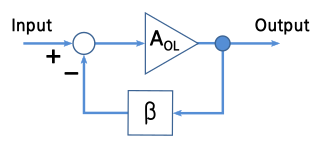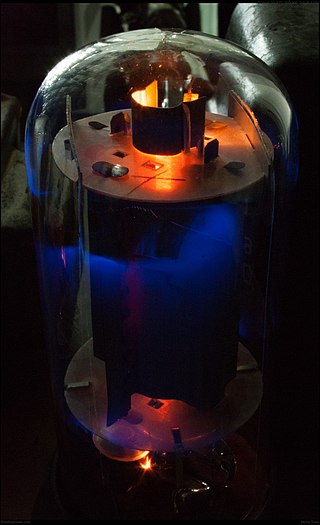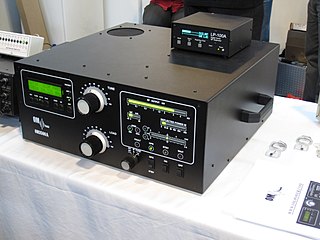Development and applications

In the 1960s, American recording studios adopted multitrack recording. Narrow tracks of multitrack recorders were noisier than wide tracks of their predecessors; mixing down many narrow tracks further degraded the signal-to-noise ratio of master tapes. [2] Mixing became a complex process requiring the precisely timed operation of numerous controls and faders, which were too numerous to operate manually. [2] These problems of early multitrack studios created a demand for professional-grade noise reduction and console automation. [2] At the core of both of these functions was the voltage-controlled amplifier (VCA). [2]
The earliest solid-state VCA topology was an attenuator rather than an amplifier; it employed a junction field-effect transistor in voltage-controlled resistance mode. [3] These attenuators, which were state of the art in the early 1970s, were successfully used in professional Dolby A and consumer Dolby B noise reduction systems but did not meet all of the demands of mixing engineers. [3] In 1968, Barrie Gilbert invented the Gilbert cell that was quickly adopted by radio and analog computer designers but lacked the precision required for studio equipment. [2] Between 1970 and 1973, David E. Blackmer invented and patented the four-transistor multiplying log-antilog cell, targeting professional audio. [2] 1989b
The Blackmer cell was more precise and had a greater dynamic range that prior VCA topologies but it required well-matched complementary transistors of both polarity types that could not yet be implemented in a silicon integrated circuit (IC). [2] Contemporary junction isolation technology offered poorly performing p-n-p transistors so integrated circuit designers had to use n-p-n transistors alone. [4] The Gilbert and Dolby circuits were easily integrated in silicon [5] [1] but the Blackmer cell had to be assembled from tediously selected, precision-matched, discrete transistors. [2] [4] To ensure isothermal operation, these metal-can transistors were firmly held together with a thermally conductive ceramic block and insulated from the environment with a steel can. The first hybrid integrated circuits of this type, the "black can" dbx202, were manufactured by Blackmer's company in 1973. Five years later, Blackmer released the improved dbx202C "gold can" hybrid IC; total harmonic distortion decreased from 0.03% to 0.01% and gain control range increased from 110 dB to 116 dB. [6] In 1980, Blackmer released a version designed by Bob Adams, the dbx2001. [7] Unlike earlier Blackmer cells that operated in lean class AB, the dbx2001 operated in class A. Distortion dropped to less than 0.001% but the noise and dynamic range of the dbx2001 were inferior to those of class AB circuits. [6] This first generation of Blackmer VCAs had a very long service life; as of 2002, analogue consoles built around the original dbx202 "cans" were still being used in professional recording studios. [8]
By 1980, complementary bipolar ICs became possible and Allison Research released the first monolithic Blackmer gain cell IC. The ECG-101, which was designed by Paul Buff, contained only the core of a modified Blackmer cell – a set of eight matched transistors – and was intended for pure class A operation. [9] [7] It had a unique sonic signature that had almost no undesirable, odd-order harmonics and was easier to stabilize than the original Blackmer cell. [9] In 1981 dbx, Inc. released their own monolithic IC, the dbx2150/2151/2155, which was designed by Dave Welland, the future co-founder of Silicon Labs. [6] [7] The three numeric designations denoted three grades of the same chip; 2151 being the best, 2155 the worst; the middle-of-the-line 2150 was the most widely used version. [6] The eight-pin single-in-line package (SIP8) assured good isolation between inputs and outputs, and became the industry standard that was used in the later dbx2100, THAT2150 and THAT2181 ICs. These circuits, like the original hybrid dbx ICs, were a small-volume niche product that was used exclusively in professional analogue audio. [8] Typical applications include mixing consoles, compressors, noise gates, duckers, de-essers and state variable filters. [10] The dbx noise reduction system, which used the Blackmer cell, had limited success in semi-professional market and failed in consumer markets, losing to Dolby C. [11] The only mass market where dbx achieved substantial use was the North American Multichannel Television Sound, which was introduced in 1984 and operating until the end of analogue television broadcasting in 2009. [12]
In the 21st century, professional Blackmer ICs are manufactured by THAT Corporation – a direct descendant of Blackmers' dbx, Inc. – using dielectric isolation technology. [4] As of April 2020, the company offered one dual-channel and two single-channel Blackmer ICs, and four "analog engine" ICs containing Blackmer cells that are controlled by Blackmer RMS detectors. [13]






















